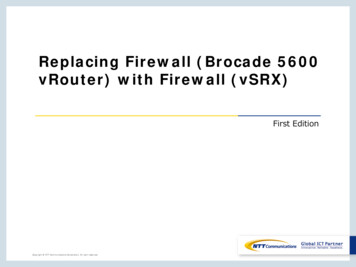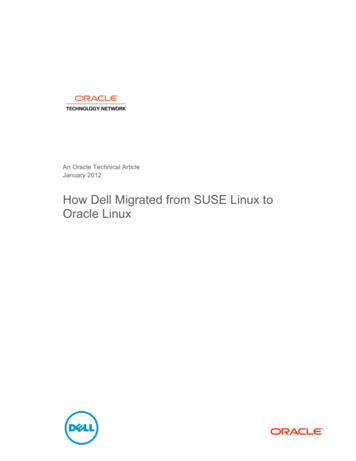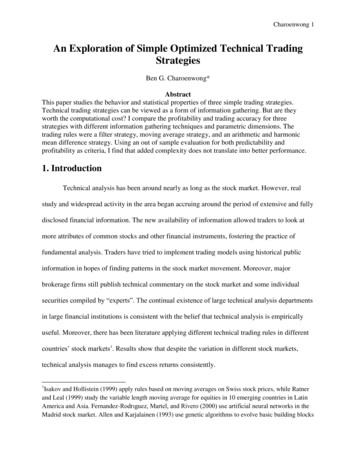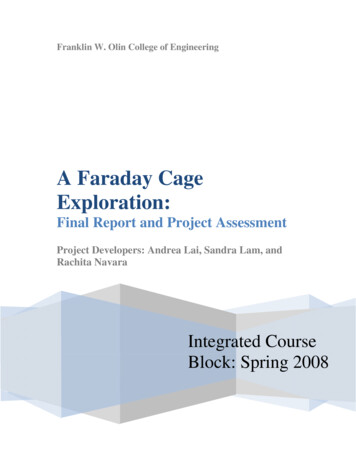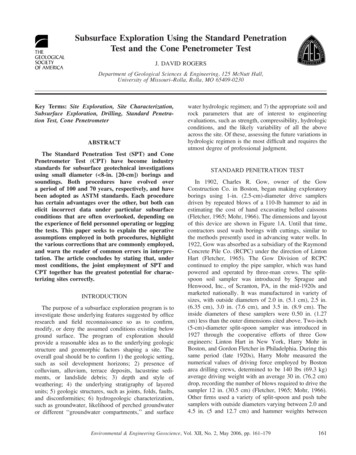
Transcription
601.443/643 – Linux Firewall Exploration Lab1Part 1: Linux Firewall Exploration LabCopyright 2006 - 2016 Wenliang Du, Syracuse University.Modifications by Tushar Jois for JHU 601.443/643, Security and Privacy in Computing.The development of this document was partially funded by the National Science Foundation under AwardNo. 1303306 and 1318814. This work is licensed under a Creative Commons Attribution-NonCommercialShareAlike 4.0 International License. A human-readable summary of (and not a substitute for) the license isthe following: You are free to copy and redistribute the material in any medium or format. You must giveappropriate credit. If you remix, transform, or build upon the material, you must distribute your contributionsunder the same license as the original. You may not use the material for commercial purposes.1OverviewThe learning objective of this lab is for students to gain the insights on how firewalls work by playingwith firewall software and implement a simplified packet filtering firewall. Firewalls have several types; inthis lab, we focus on packet filter. Packet filters inspect packets, and decide whether to drop or forwarda packet based on firewall rules. Packet filters are usually stateless; they filter each packet based only onthe information contained in that packet, without paying attention to whether a packet is part of an existingstream of traffic. Packet filters often use a combination of a packet’s source and destination address, itsprotocol, and, for TCP and UDP traffic, port numbers. In this lab, students will play with this type offirewall, and also through the implementation of some of the key functionalities, they can understand howfirewalls work. Moreover, students will learn how to use SSH tunnels to bypass firewalls. This lab coversthe following topics: FirewallNetfilterLoadable kernel moduleSSH tunnelReadings. Detailed coverage of Firewalls can be found in Chapter 14 of the SEED book, Computer Security: A Hands-on Approach, by Wenliang Du.Lab environment.from Blackboard.22.1This lab has been tested on our pre-built Ubuntu 16.04 VM, which can be downloadedLab TasksTask 1: Using FirewallLinux has a tool called iptables, which is essentially a firewall. It has a nice front end program calledufw, but we won’t use that in this lab. In this task, the objective is to use iptables to set up some firewallpolicies, and observe the behaviors of your system after the policies become effective. You need to set up atleast two VMs, one called Machine A, and other called Machine B. You run the firewall on your MachineA. Basically, we use iptables as a personal firewall. Optionally, if you have more VMs, you can set up afirewall at your router, so it can protect a network, instead of just one single computer. After you set up thetwo VMs, you should perform the following tasks:
601.443/643 – Linux Firewall Exploration Lab2 Prevent A from doing telnet to Machine B. Prevent B from doing telnet to Machine A. Prevent A from visiting an external web site. You can choose any web site that you like to block, butkeep in mind, some web servers have multiple IP addresses.You can find the manual of iptables by typing "man iptables" or search it online. Beforestarting the task, run the following commands:\ sudo ufw disable\ sudo iptables -F2.2# we’re NOT using ufw# flush all iptables rulesTask 2: Implementing a Simple FirewallThe firewall you used in the previous task is a packet filtering type of firewall. The main part of this type offirewall is the filtering part, which inspects each incoming and outgoing packets, and enforces the firewallpolicies set by the administrator. Since the packet processing is done within the kernel, the filtering mustalso be done within the kernel. Therefore, it seems that implementing such a firewall requires us to modifythe Linux kernel. In the past, this had to be done by modifying and rebuilding the kernel. The modernLinux operating systems provide several new mechanisms to facilitate the manipulation of packets withoutrebuilding the kernel image. These two mechanisms are Loadable Kernel Module (LKM) and Netfilter.LKM allows us to add a new module to the kernel at the runtime. This new module enables us to extendthe functionalities of the kernel, without rebuilding the kernel or even rebooting the computer. The packetfiltering part of a firewall can be implemented as an LKM. However, this is not enough. In order for thefiltering module to block incoming/outgoing packets, the module must be inserted into the packet processingpath. This cannot be easily done in the past before the Netfilter was introduced into the Linux.Netfilter is designed to facilitate the manipulation of packets by authorized users. Netfilterachieves this goal by implementing a number of hooks in the Linux kernel. These hooks are inserted intovarious places, including the packet incoming and outgoing paths. If we want to manipulate the incomingpackets, we simply need to connect our own programs (within LKM) to the corresponding hooks. Once anincoming packet arrives, our program will be invoked. Our program can decide whether this packet shouldbe blocked or not; moreover, we can also modify the packets in the program.In this task, you need to use LKM and Netfilter to implement the packet filtering module. Thismodule will fetch the firewall policies from a data structure, and use the policies to decide whether packetsshould be blocked or not. To make your life easier, so you can focus on the filtering part, the core offirewalls, we allow you to hardcode your firewall policies in the program. You should support at least fivedifferent rules, including the ones specified in the previous task. Guidelines on how to use Netfilter canbe found in Section 3. In addition, Chapter 14 (§14.4) of the SEED book provides more detailed explanationon Netfilter.2.3Task 3: Evading Egress FilteringMany companies and schools enforce egress filtering, which blocks users inside of their networks fromreaching out to certain web sites or Internet services. They do allow users to access other web sites. In manycases, this type of firewalls inspect the destination IP address and port number in the outgoing packets. Ifa packet matches the restrictions, it will be dropped. They usually do not conduct deep packet inspections(i.e., looking into the data part of packets) due to the performance reason. In this task, we show how such
601.443/643 – Linux Firewall Exploration Lab3egress filtering can be bypassed using the tunnel mechanism. There are many ways to establish tunnels; inthis task, we only focus on SSH tunnels.You need two VMs A and B for this task (three will be better). Machine A is running behind a firewall(i.e., inside the company or school’s network), and Machine B is outside of the firewall. Typically, thereis a dedicated machine that runs the firewall, but in this task, for the sake of convenience, you can run thefirewall on Machine A. You must use the firewall program that you implemented in the previous task, andcannot use iptables or ufw. You need to set up the following two firewall rules: Block all the outgoing traffic to external telnet servers. In reality, the servers that are blocked are usually game servers or other types of servers that may affect the productivity of employees. In this task,we use the telnet server for demonstration purposes. You can run the telnet server on Machine B. Ifyou have a third VM, Machine C, you can run the telnet server on Machine C. Block all the outgoing traffic to www.facebook.com, so employees (or school kids) are not distracted during their work/school hours. Social network sites are commonly blocked by companiesand schools. After you set up the firewall, launch your Firefox browser, and try to connect to Facebook, and report what happens. If you have already visited Facebook before using this browser,you need to clear all the caches using Firefox’s menu: Edit - Preferences - Privacy& Security (left pane) - Clear History (Button on right); otherwise, thecached pages may be displayed. If everything is set up properly, you should not be able to see Facebook pages. It should be noted that Facebook has many IP addresses, it can change over the time.Remember to check whether the address is still the same by using ping or dig command. If theaddress has changed, you need to update your firewall rules. You can also choose web sites with staticIP addresses, instead of using Facebook. For example, most universities’ web servers use static IPaddresses (e.g. www.syr.edu); for demonstration purposes, you can try block these IPs, instead ofFacebook.FirewallTelnetserver 23Machine: workTelnetclientssh client800022Machine: homessh serverMachine: apolloFigure 1: SSH Tunnel ExampleTask 3.a: Telnet to Machine B through the firewall To bypass the firewall, we can establish an SSHtunnel between Machine A and B, so all the telnet traffic will go through this tunnel (encrypted), evading the
601.443/643 – Linux Firewall Exploration Lab4inspection. Figure 1 illustrates how the tunnel works. The following command establishes an SSH tunnelbetween the localhost (port 8000) and machine B (using the default port 22); when packets come out of B’send, it will be forwarded to Machine C’s port 23 (telnet port). If you only have two VMs, you can useone VM for both Machine B and Machine C. ssh -L 8000:Machine C IP:23seed@Machine B IP// We can now telnet to Machine C via the tunnel: telnet localhost 8000When we telnet to localhost’s port 8000, SSH will transfer all our TCP packets from one endof the tunnel on localhost:8000 to the other end of the tunnel on Machine B; from there, the packetswill be forwarded to Machine C:23. Replies from Machine C will take a reverse path, and eventuallyreach our telnet client. Essentially, we are able to telnet to Machine C. Please describe your observation andexplain how you are able to bypass the egress filtering. You should use Wireshark to see what exactly ishappening on the wire.Task 3.b: Connect to Facebook using SSH Tunnel. To achieve this goal, we can use the approachsimilar to that in Task 3.a, i.e., establishing a tunnel between your localhost:port and Machine B, and ask Bto forward packets to Facebook. To do that, you can use the following command to set up the tunnel: "ssh-L 8000:FacebookIP:80 .". We will not use this approach, and instead, we use a more genericapproach, called dynamic port forwarding, instead of a static one like that in Task 3.a. To do that, we onlyspecify the local port number, not the final destination. When Machine B receives a packet from the tunnel,it will dynamically decide where it should forward the packet to based on the destination information of thepacket. ssh -D 9000 -C seed@machine BSimilar to the telnet program, which connects localhost:9000, we need to ask Firefox to connectto localhost:9000 every time it needs to connect to a web server, so the traffic can go through our SSHtunnel. To achieve that, we can tell Firefox to use localhost:9000 as its proxy. To support dynamic portforwarding, we need a special type of proxy called SOCKS proxy, which is supported by most browsers. Toset up the proxy in Firefox, go to the menu bar, click Edit - Preferences, scroll down to NetworkProxy, and click the Settings button. Then follow Figure 2. After the setup is done, please do thefollowing:1. Run Firefox and go visit the Facebook page. Can you see the Facebook page? Please describe yourobservation.2. After you get the facebook page, break the SSH tunnel, clear the Firefox cache, and try the connectionagain. Please describe your observation.3. Establish the SSH tunnel again and connect to Facebook. Describe your observation.4. Please explain what you have observed, especially on why the SSH tunnel can help bypass the egressfiltering. You should use Wireshark to see what exactly is happening on the wire. Please describeyour observations and explain them using the packets that you have captured.
601.443/643 – Linux Firewall Exploration Lab5Figure 2: Configure the SOCKS Proxy2.4Task 4: Evading Ingress FilteringMachine A runs a web server behind a firewall; so only the machines in the internal network can accessthis web server. You are working from home and needs to access this internal web server. You do not haveVPN, but you have SSH, which is considered as a poor man’s VPN. You do have an account on Machine A(or another internal machine behind the firewall), but the firewall also blocks incoming SSH connection, soyou cannot SSH into any machine on the internal network. Otherwise, you can use the same technique fromTask 3 to access the web server. The firewall, however, does not block outgoing SSH connection, i.e., if youwant to connect to an outside SSH server, you can still do that.The objective of this task is to be able to access the web server on Machine A from outside. We will usetwo machines to emulate the setup. Machine A is the internal computer, running the protected web server;Machine B is the outside machine at home. On Machine A, we block Machine B from accessing its port 80(web server) and 22 (SSH server). You need to set up a reverse SSH tunnel on Machine A, so once you gethome, you can still access the protected web server on A from home.33.1GuidelinesLoadable Kernel ModuleThe following is a simple loadable kernel module. It prints out "Hello World!" when the module isloaded; when the module is removed from the kernel, it prints out "Bye-bye World!". The messages
601.443/643 – Linux Firewall Exploration Lab6are not printed out on the screen; they are actually printed into the /var/log/syslog file. You can usedmesg tail -10 to read the last 10 lines of message.#include linux/module.h #include linux/kernel.h int init module(void){printk(KERN INFO "Hello World!\n");return 0;}void cleanup module(void){printk(KERN INFO "Bye-bye World!.\n");}We now need to create Makefile, which includes the following contents (the above program is namedhello.c). Then just type make, and the above program will be compiled into a loadable kernel module.obj-m hello.oall:make -C /lib/modules/ (shell uname -r)/build M (PWD) modulesclean:make -C /lib/modules/ (shell uname -r)/build M (PWD) cleanOnce the module is built by typing make, you can use the following commands to load the module, listall modules, and remove the module: sudo insmod mymod.ko lsmod sudo rmmod mymod.ko(inserting a module)(list all modules)(remove the module)Also, you can use modinfo mymod.ko to show information about a Linux Kernel module.3.2A Simple Program that Uses NetfilterUsing Netfilter is quite straightforward. All we need to do is to hook our functions (in the kernelmodule) to the corresponding Netfilter hooks. Here we show an example:#include#include#include#include linux/module.h linux/kernel.h linux/netfilter.h linux/netfilter ipv4.h /* This is the structure we shall use to register our function */static struct nf hook ops nfho;/* This is the hook function itself */unsigned int hook func(void *priv, struct sk buff *skb,const struct nf hook state *state)
601.443/643 – Linux Firewall Exploration Lab7{/* This is where you can inspect the packet contained inthe structure pointed by skb, and decide whether to acceptor drop it. You can even modify the packet */// In this example, we simply drop all packetsreturn NF DROP;/* Drop ALL packets */}/* Initialization routine */int init module(){/* Fill in our hook structure */nfho.hook hook func;/* Handler function */nfho.hooknum NF INET PRE ROUTING; /* First hook for IPv4 */nfho.pf PF INET;nfho.priority NF IP PRI FIRST;/* Make our function first */nf register hook(&nfho);return 0;}/* Cleanup routine */void cleanup module(){nf unregister hook(&nfho);}4Submission and DemonstrationStudents need to submit a detailed lab report to describe what they have done, what they have observed,and explanation. Reports should include the evidences to support the observations. Evidences includepacket traces, screendumps, etc. Students also need to answer all the questions in the lab description. Forthe programming tasks, students should list the important code snippets followed by explanation. Simplyattaching code without any explanation is not enough.This is a “lab report”, not a problem set: writing in clear, concise English is a part of the exercise (andthe grade). Make sure you describe, step-by-step, your process. We want to be able to recreate your resultsby following your steps exactly. Logical leaps between steps will result in point deductions. Do not be afraidto include issues you faced, and how you solved them. Note that you must answer all questions in paragraphform for full credit. Look at the example report on Blackboard for an idea of what we are expecting.When you are ready to submit your lab report for this lab, upload it to Gradescope with the following format: lab-report-aXpY-jhed.pdf, where X is the assignment number Y is the part number,and jhed is your JHED (email-based). For example, Tushar Jois would submit Assignment 5, Part 2 aslab-report-a5p2-tjois1.pdf. DOCX and other formats will not be accepted.
601.443/643 – Linux Firewall Exploration LabA8Firewall Lab Cheat SheetHeader Files. You may need to take a look at several header files, including the skbuff.h, ip.h,icmp.h, tcp.h, udp.h, and netfilter.h. They are stored in the following folder:/lib/modules/ (uname -r)/build/include/linux/IP Header.dresses.The following code shows how you can get the IP header, and its source/destination IP ad-struct iphdr *ip header (struct iphdr *)skb network header(skb);unsigned int src ip (unsigned int)ip header- saddr;unsigned int dest ip (unsigned int)ip header- daddr;TCP/UDP Header. The following code shows how you can get the UDP header, and its source/destinationport numbers. It should be noted that we use the ntohs() function to convert the unsigned short integerfrom the network byte order to the host byte order. This is because in the 80x86 architecture, the host byteorder is the Least Significant Byte first, whereas the network byte order, as used on the Internet, is MostSignificant Byte first. If you want to put a short integer into a packet, you should use htons(), which isreverse to ntohs().struct udphdr *udp header (struct udphdr *)skb transport header(skb);src port (unsigned int)ntohs(udp header- source);dest port (unsigned int)ntohs(udp header- dest);IP Addresses in different formats. You may find the following library functions useful when you convertIP addresses from one format to another (e.g. from a string "128.230.5.3" to its corresponding integerin the network byte order or the host byte order.int inet aton(const char *cp, struct in addr *inp);in addr t inet addr(const char *cp);in addr t inet network(const char *cp);char *inet ntoa(struct in addr in);struct in addr inet makeaddr(int net, int host);in addr t inet lnaof(struct in addr in);in addr t inet netof(struct in addr in);
Detailed coverage of Firewalls can be found in Chapter 14 of the SEED book, Computer Secu-rity: A Hands-on Approach, by Wenliang Du. Lab environment. This lab has been tested on our pre-built Ubuntu 16.04 VM, which can be downloaded from Blackboard. 2 Lab Tasks 2.1 Task 1: Using Firewall Lin
